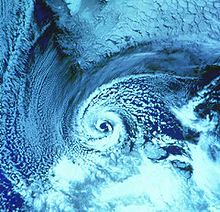Polar low
Polar lows can be difficult to detect using conventional weather reports and are a hazard to high-latitude operations, such as shipping and gas and oil platforms.
[2] Polar lows were first identified on the meteorological satellite imagery that became available in the 1960s, which revealed many small-scale cloud vortices at high latitudes.
Antarctic systems tend to be weaker than their northern counterparts since the air-sea temperature differences around the continent are generally smaller.
A number of lows develop on horizontal temperature gradients through baroclinic instability, and these can have the appearance of small frontal depressions.
Some cargo and shipping vessels are also affected, although there are minimal or no reports of losses in recent years as the result of a polar low.
On December 28, 1986, seven passenger cars of a railway train were blown from the Amarube Viaduct due to a polar low, causing six deaths.


